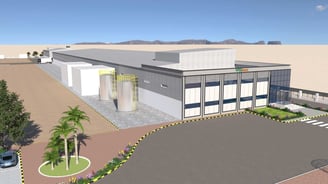Add your promotional text...
India’s Warehousing Boom: Manufacturing Drives Record Growth Across Key Markets
Synopsis: India’s warehousing sector is witnessing unprecedented growth, with a 20% rise in transactions in Q3 2024 compared to the previous year. The manufacturing sector has outpaced traditional third-party logistics (3PL) in leasing volumes, signaling a transformative shift. This blog delves into the key drivers, market trends, and future implications of this robust growth.
VIEWS ON NEWS
By Monika Agarwal
11/26/20243 min read


The Indian warehousing sector is on a growth trajectory, driven largely by the manufacturing industry. According to a recent report by Knight Frank India, warehouse transactions across eight key markets surged by 20% in Q3 2024, reaching 14.65 million square feet (mn sq ft). This marks a significant shift as manufacturing outpaces the traditionally dominant third-party logistics (3PL) sector in leasing activity, reshaping the dynamics of India’s warehousing market.
Manufacturing Leads the Way
For the first time in years, the manufacturing sector has surpassed 3PL in leasing volumes. Manufacturing industries accounted for a remarkable 37% of total transactions from January to September 2024, leasing over 14 mn sq ft. The report attributes this growth to expanding industrial activities, increased investment in infrastructure, and India’s rise as a global manufacturing hub.
This surge highlights the growing importance of warehousing in the country’s manufacturing ecosystem, enabling seamless supply chain operations and supporting India’s “Make in India” initiatives.
Steady Growth in Transaction Volumes
The year-to-date warehousing transaction volumes stood at 37.54 mn sq ft by the end of September 2024, a 4% year-on-year (YoY) increase. The steady expansion reflects the robust demand for warehousing spaces, particularly Grade A facilities, which accounted for 41% of the total transactions during the quarter.
This shift toward high-quality infrastructure indicates occupiers’ preference for modern, efficient spaces that align with global standards.
Market Performance: Pune Takes the Lead
Among the eight key markets analyzed, Pune emerged as the leader, accounting for 23% of the total warehousing volume. The city’s dominance is attributed to the strong presence of the 3PL sector and its strategic location, which makes it a preferred logistics hub.
NCR followed with 13% of the total volume, driven by activity in both the 3PL and manufacturing sectors. Other cities like Mumbai, Chennai, and Kolkata also reported healthy transaction volumes, showcasing a well-distributed demand across regions.
Rental Trends: Pune Tops the Charts
Pune also emerged as the most expensive warehousing rental market in Q3 2024, with an average rent of ₹26.9/sq ft/month. Kolkata, Chennai, and Mumbai followed closely at ₹23.9/sq ft/month each.
Limited supply has been a key driver of rental growth, with Pune recording a 4% YoY increase, the highest among the cities. Ahmedabad ranked second, with a 3.5% YoY rental growth during the same period. These figures underscore the growing value of warehousing spaces in prime locations.
E-Commerce and Retail: Rising Stars
E-commerce and retail occupiers have seen substantial growth in 2024, with transaction volumes increasing by 34% and 35% YoY, respectively. While still smaller compared to manufacturing and 3PL, their market shares have grown to 9% and 11%.
This diversification in occupier base reflects the sector’s evolution, as demand now comes from a broader range of industries, including fast-growing e-commerce platforms and modern retail chains.
Expert Insights on Growth
Shishir Baijal, Chairman and Managing Director of Knight Frank India, commented on the sector’s resilience:
“Robust investments and a resilient Indian economy have sustained corporate confidence, driving consistent activity in the warehousing sector. The rising trend highlights the sector's pivotal role in supporting India’s economic growth and its readiness for future opportunities.”
The growth in warehousing is also supported by government initiatives, improved infrastructure, and a strong investment pipeline, all of which are critical for sustaining momentum.
Implications and Opportunities
The warehousing sector’s growth reflects India’s economic vibrancy and industrial expansion. Key takeaways from the current trends include:
Increased Investment in Grade A Spaces: The demand for modern infrastructure indicates a shift towards efficiency and sustainability in logistics.
Diversified Occupier Base: The rise of e-commerce and retail players signals a broadening market, offering opportunities for developers to cater to varied needs.
Strategic Regional Growth: Pune and NCR continue to dominate, but cities like Ahmedabad and Kolkata are emerging as strong contenders, presenting new investment avenues.
Focus on Value Appreciation: Rental growth across markets points to the long-term value of warehousing investments, particularly in high-demand areas.
Looking Ahead
India’s warehousing market is poised for sustained growth, supported by rising industrial activities, technological advancements, and robust economic fundamentals. As manufacturing continues to drive demand, the sector is set to play a critical role in India’s journey towards becoming a global logistics powerhouse.
The increasing interest from diverse sectors, coupled with steady rental appreciation, presents significant opportunities for investors and developers. By focusing on quality infrastructure and strategic market expansion, the sector can unlock its full potential, driving India’s economic growth for years to come.
The future of Indian warehousing is bright, and the trends of 2024 offer a glimpse of the transformative changes ahead.
